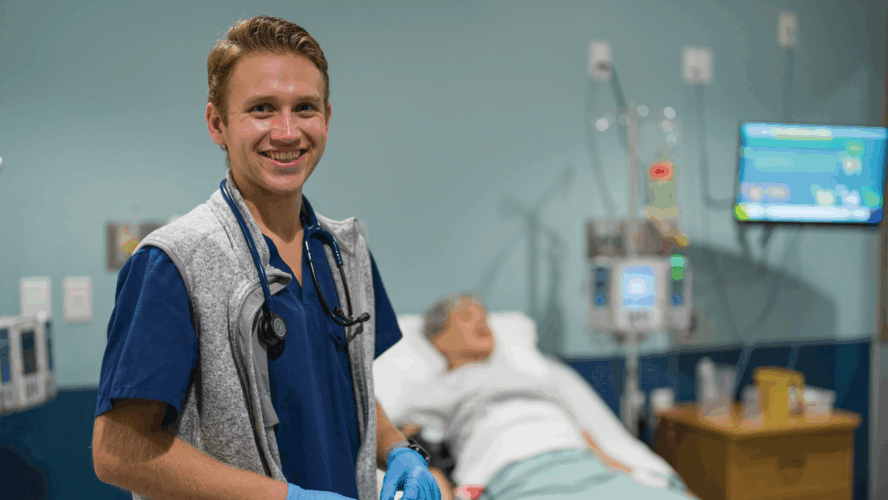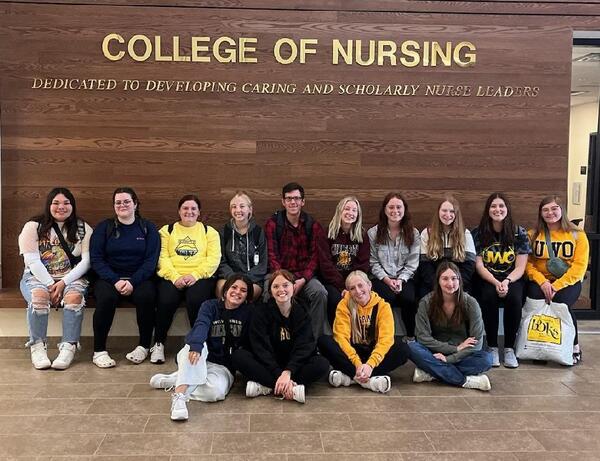I had the privilege of attending a nursing conference at Creighton University. From the moment the first keynote speaker began to share, I felt deeply inspired. Her words focused on the foundational role nursing theorists and their frameworks play in shaping our professional identity. As someone with more than 30 years in this field, her reflections stirred something meaningful in me. It reminded me that the journey to becoming a strong nurse—and an enthusiastic, confident educator—is never a solo effort. We are shaped and supported by those around us: our families, mentors, peers, administrators, and communities.
Our mentors model excellence and cheer us on, encouraging us to aim higher and trust our abilities. Our peers walk beside us, offering camaraderie, support, and shared wisdom. A strong administration gives us the resources, trust, and space to innovate—to build thoughtful curricula and design meaningful assessments. Together, they help us grow in ways we may not always recognize in the moment but deeply appreciate in hindsight.
Be an Advocate
One of my earliest mentors showed me that being an educator is about more than teaching content—it’s about showing up and being a reliable advocate. She was the first to model what it means to truly be there for students, during both their triumphs and their hardest moments. Her open-door policy wasn’t just a phrase—it was a way of life. Through her, I learned that advocacy means listening, guiding, and supporting with consistency and compassion. It’s a daily practice of presence and empathy, and it’s where true impact begins.
Set the Bar High
“Set the bar high, and students will strive to reach it.” Those words, shared with me by a mentor years ago, continue to guide my philosophy. She believed in the boundless potential of every student and taught me that high expectations, paired with strong support, yield incredible growth. I have seen this in action countless times. When we show students that we believe in their capabilities, they rise—not just to meet the challenge, but often to surpass it.
Be a Cheerleader
One of the most joyful lessons I learned from a mentor was to bring genuine enthusiasm into the classroom. A smile can shift the energy in a room. She encouraged me to use affirmations and call-and-response interactions to build confidence and connection. Small moments, like telling students, “You are capable, confident, and ready,” go a long way. With her influence, I learned to energize a room and help students believe in themselves through positivity and encouragement.
Be Innovative
I was lucky to be mentored by educators who challenged me to move beyond traditional teaching methods. They encouraged me to embrace active learning, to create space where students become participants rather than passive listeners. These mentors inspired me to design experiences that reflect the real world our students will step into—fast-paced, complex, and collaborative. They also reminded me to have fun, to bring my full self into the classroom, and to enjoy the creativity and spontaneity that comes with teaching.
Find Your Theme
One mentor encouraged me to find my scholarly “theme”—an area that aligned with my passion and values. She emphasized that impactful scholarship isn’t just about output; it’s about focus, authenticity, and purpose. Through her mentorship, I found my academic voice. She pushed me to take chances, refine my work, and stay aligned with what truly matters to me. Because of her, I continue to approach writing and research with purpose and pride.
Step Outside Your Comfort Zone
Growth often begins with discomfort, and one mentor was instrumental in helping me embrace that truth. She encouraged me to try new teaching strategies and take risks, even when they felt uncertain. Her example helped me see failure not as defeat, but as an essential part of learning. She taught me to model resilience and curiosity—traits I now pass along to my students.
Be Confident
Confidence as an educator doesn’t come overnight, and for me, a peer played a key role in building that. She guided me in designing exam questions that challenge critical thinking and reflect real-world application. Her belief in my abilities helped me believe in myself. Thanks to her, I now approach assessments as a vital, thoughtful part of the learning process.
Meaningful Connections
Over the years, I’ve formed lasting connections with peers who have become dear friends. Even while teaching at different institutions, our collaboration has remained strong. We share resources, brainstorm, and support each other. These partnerships are more than professional—they’re deeply personal, and they remind me how important it is to foster connection in our work.
Work-Life Balance
Recently, a peer helped me realize the value of setting boundaries and honoring my well-being. She taught me that time for rest, family, and joy is essential—not a luxury. Her example helped me reframe self-care as a necessity for sustained excellence. Today, I prioritize balance, and it’s made me a more effective, fulfilled educator.
Spirituality and Compassion
A mentor once reminded me that spirituality is an essential part of holistic nursing. She taught me that kindness, compassion, and a joyful heart—especially one filled with color (purple, in her case!)—are just as important as clinical skills. Her teachings helped me understand that healing involves the whole person, and that our energy, presence, and spirit deeply affect those we serve.
Joy and Motivation
One of my greatest sources of daily encouragement is my son. His love, his kind words, and his constant support fuel my motivation and joy. He reminds me to live fully, to stay grateful, and to appreciate each moment. Knowing he’s proud of me pushes me to be my best, every single day.
Without Limitation
A dear friend once told me that I deserve all the good things life has to offer—and that I should never doubt my worth. Her belief in me helped me overcome self-imposed limits. Because of her, I’ve stepped into new opportunities with courage, knowing I am capable and deserving.
Cultural Respect and Humility
One of the most impactful lessons I’ve learned came from a mentor who emphasized cultural humility. She taught me to approach every person as a unique individual, with their own story, values, and needs. In both education and care, respect and humility create space for genuine connection and better outcomes. I strive to carry this mindset into every classroom and clinical setting.
My Foundation
At the start of my journey, a mentor believed in me when I struggled to believe in myself. She urged me to pursue my graduate degree and never let me settle for less than my full potential. Her faith in me laid the foundation for the educator I’ve become. I carry her lessons with me daily and hope I’ve made her proud.
An Honor to Witness
Every day, I learn from my students. Their empathy, dedication, and curiosity inspire me. They cheer each other on, advocate for others, and bring fresh perspectives into the classroom. It’s an honor to witness their growth and to be part of their journey. They are already showing the compassion and leadership that will define their futures in nursing.
Future Leaders
The students I mentor often think I’m guiding them—but the truth is, they inspire me. Their passion and eagerness to become nurse educators push me to reflect, evolve, and reach higher. They remind me why I chose this path: to make a difference and help others do the same. They are the future of nursing education, and I’m proud to be a part of their development.
The Sigma conference was more than an event—it was a heartfelt reminder that growth in nursing and education is a shared journey. The keynote speaker’s message brought me back to the many people who have walked with me these past three decades. I am who I am today because of their mentorship, encouragement, and belief in me. As we move forward in our profession, may we all strive to lift others as we have been lifted—to teach, lead, and advocate with purpose, passion, and heart.
Dr. Maureen Hermann earned her BSN (1995), MSN (2011), and DNP (2016), with an emphasis in leadership, from Saint Francis Medical Center College of Nursing in Peoria, IL. Dr. Maureen Hermann is an Associate Professor at Creighton University, Omaha, Nebraska.
















